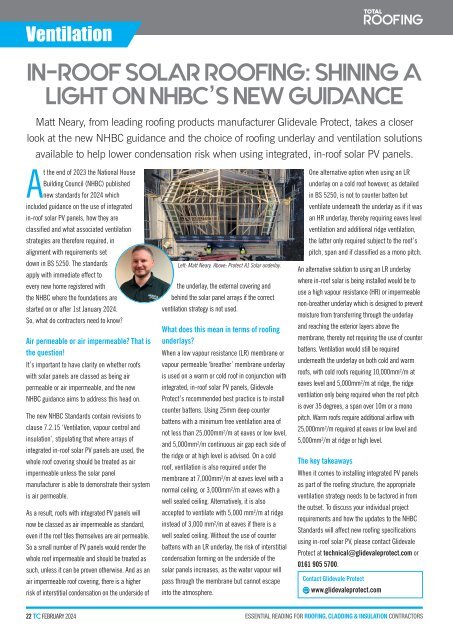February 2024
Create successful ePaper yourself
Turn your PDF publications into a flip-book with our unique Google optimized e-Paper software.
Ventilation<br />
IN-ROOF SOLAR ROOFING: SHINING A<br />
LIGHT ON NHBC’S NEW GUIDANCE<br />
Matt Neary, from leading roofing products manufacturer Glidevale Protect, takes a closer<br />
look at the new NHBC guidance and the choice of roofing underlay and ventilation solutions<br />
available to help lower condensation risk when using integrated, in-roof solar PV panels.<br />
At the end of 2023 the National House<br />
Building Council (NHBC) published<br />
new standards for <strong>2024</strong> which<br />
included guidance on the use of integrated<br />
in-roof solar PV panels, how they are<br />
classified and what associated ventilation<br />
strategies are therefore required, in<br />
alignment with requirements set<br />
down in BS 5250. The standards<br />
apply with immediate effect to<br />
every new home registered with<br />
the NHBC where the foundations are<br />
started on or after 1st January <strong>2024</strong>.<br />
So, what do contractors need to know?<br />
Air permeable or air impermeable? That is<br />
the question!<br />
It’s important to have clarity on whether roofs<br />
with solar panels are classed as being air<br />
permeable or air impermeable, and the new<br />
NHBC guidance aims to address this head on.<br />
The new NHBC Standards contain revisions to<br />
clause 7.2.15 ‘Ventilation, vapour control and<br />
insulation’, stipulating that where arrays of<br />
integrated in-roof solar PV panels are used, the<br />
whole roof covering should be treated as air<br />
impermeable unless the solar panel<br />
manufacturer is able to demonstrate their system<br />
is air permeable.<br />
As a result, roofs with integrated PV panels will<br />
now be classed as air impermeable as standard,<br />
even if the roof tiles themselves are air permeable.<br />
So a small number of PV panels would render the<br />
whole roof impermeable and should be treated as<br />
such, unless it can be proven otherwise. And as an<br />
air impermeable roof covering, there is a higher<br />
risk of interstitial condensation on the underside of<br />
Left: Matt Neary. Above: Protect A1 Solar underlay.<br />
the underlay, the external covering and<br />
behind the solar panel arrays if the correct<br />
ventilation strategy is not used.<br />
What does this mean in terms of roofing<br />
underlays?<br />
When a low vapour resistance (LR) membrane or<br />
vapour permeable ‘breather’ membrane underlay<br />
is used on a warm or cold roof in conjunction with<br />
integrated, in-roof solar PV panels, Glidevale<br />
Protect’s recommended best practice is to install<br />
counter battens. Using 25mm deep counter<br />
battens with a minimum free ventilation area of<br />
not less than 25,000mm²/m at eaves or low level,<br />
and 5,000mm²/m continuous air gap each side of<br />
the ridge or at high level is advised. On a cold<br />
roof, ventilation is also required under the<br />
membrane at 7,000mm²/m at eaves level with a<br />
normal ceiling, or 3,000mm²/m at eaves with a<br />
well sealed ceiling. Alternatively, it is also<br />
accepted to ventilate with 5,000 mm²/m at ridge<br />
instead of 3,000 mm²/m at eaves if there is a<br />
well sealed ceiling. Without the use of counter<br />
battens with an LR underlay, the risk of interstitial<br />
condensation forming on the underside of the<br />
solar panels increases, as the water vapour will<br />
pass through the membrane but cannot escape<br />
into the atmosphere.<br />
One alternative option when using an LR<br />
underlay on a cold roof however, as detailed<br />
in BS 5250, is not to counter batten but<br />
ventilate underneath the underlay as if it was<br />
an HR underlay, thereby requiring eaves level<br />
ventilation and additional ridge ventilation,<br />
the latter only required subject to the roof’s<br />
pitch, span and if classified as a mono pitch.<br />
An alternative solution to using an LR underlay<br />
where in-roof solar is being installed would be to<br />
use a high vapour resistance (HR) or impermeable<br />
non-breather underlay which is designed to prevent<br />
moisture from transferring through the underlay<br />
and reaching the exterior layers above the<br />
membrane, thereby not requiring the use of counter<br />
battens. Ventilation would still be required<br />
underneath the underlay on both cold and warm<br />
roofs, with cold roofs requiring 10,000mm²/m at<br />
eaves level and 5,000mm²/m at ridge, the ridge<br />
ventilation only being required when the roof pitch<br />
is over 35 degrees, a span over 10m or a mono<br />
pitch. Warm roofs require additional airflow with<br />
25,000mm²/m required at eaves or low level and<br />
5,000mm²/m at ridge or high level.<br />
The key takeaways<br />
When it comes to installing integrated PV panels<br />
as part of the roofing structure, the appropriate<br />
ventilation strategy needs to be factored in from<br />
the outset. To discuss your individual project<br />
requirements and how the updates to the NHBC<br />
Standards will affect new roofing specifications<br />
using in-roof solar PV, please contact Glidevale<br />
Protect at technical@glidevaleprotect.com or<br />
0161 905 5700.<br />
Contact Glidevale Protect<br />
www.glidevaleprotect.com<br />
22 TC FEBRUARY <strong>2024</strong>
















